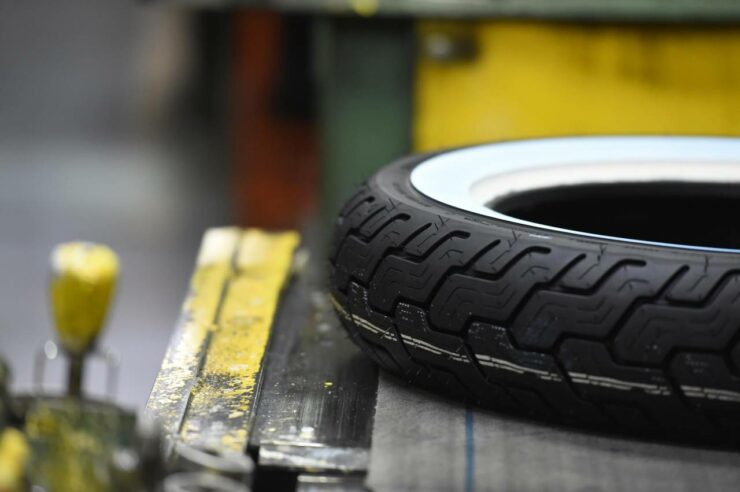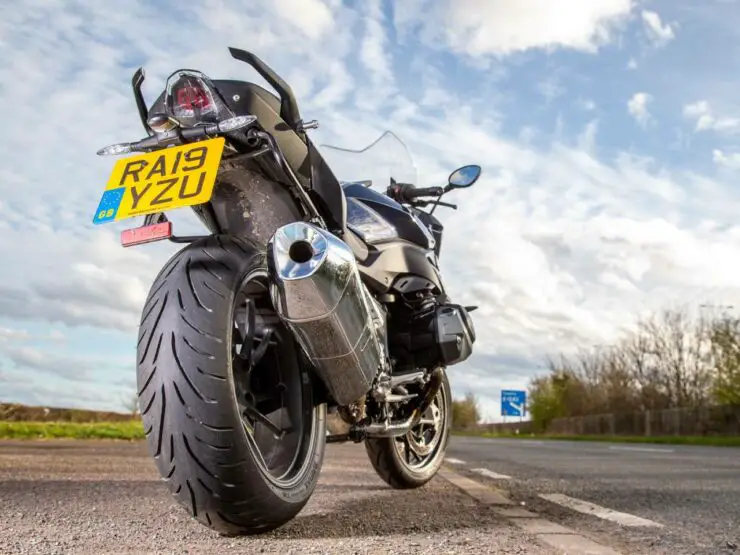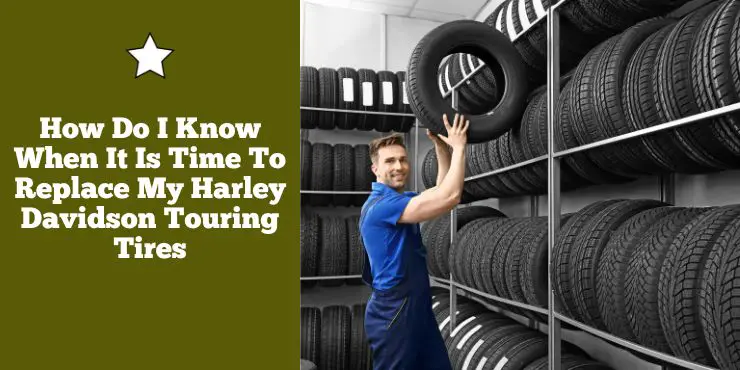It is a common question among Harley-Davidson Touring riders: how do I know when it’s time to replace my tires? Driving on worn tires can lead to poor performance, decreased fuel efficiency, and even safety risks.
Replace your touring tires when tread depth reaches 2/32 of an inch, you notice uneven wear, sidewall cracking, or a significant drop in grip, especially in wet conditions.
In this article, we will explore how to tell when it’s time to replace your Harley-Davidson Touring tires and what you should consider when choosing a new set. Read on to learn all you need to know about your Harley-Davidson Touring tires and how to get the most out of them!
How do I know when it is time to replace my Harley-Davison Touring Tires?
Harley-Davidson bikes are a symbol of freedom and adventure. These bikes are built to take you on unforgettable journeys. However, to ensure you have a safe and enjoyable ride, it’ll be important to keep a close eye on your tires’ condition. Harley-Davidson Touring Tires play a key role in your riding experience, comfort, and safety.
While these tires make sure you get an enjoyable ride whenever you go out, with time, they tend to become degraded and you need to change it otherwise your bike’s performance and your safety is at risk. Now, you may wonder, how do I know when it is time to replace my Harley-Davidson Touring Tires? There are multiple signs that indicate it is time to replace your Harley-Davidson Touring Tires. Here are some of the visible signs that indicate it is time to replace the touring tires on your Harley-Davidson bike, allowing you to embark on your next adventure with confidence.
#1. Visible signs of damage
You must inspect your Harley-Davidson Touring Tires regularly for cuts, punctures, or any foreign objects embedded in the rubber. These visible signs of damage can greatly compromise your tire’s structural integrity, leading to reduced performance and safety.
Moreover, cracks or bulges on the sidewalls or tread of the tires are clear indicators of potential problems. These issues can result from hitting potholes, curbs, or other road hazards. Cracks can weaken the tire’s structure whereas bulges suggest internal damage that can result in a blowout if left unaddressed.
#2. Degradation of performance
If you notice a decline in traction, especially on wet or slippery surfaces, it is a sign that your Harley-Davidson Touring Tires may be nearing the end of their lifespan. Reduced traction compromises your ability to safely navigate various road conditions.
Diminished tire performance can result in increased stopping distances, putting you and others around you at risk. If you find that your bike takes longer to come to a halt, it’ll be time to assess the condition of your tires.
Moreover, if your bike’s handling becomes less predictable or feels unstable, it might be due to tire wear or damage. Difficulty in cornering, instability in curves, or a shaky ride are all indications that your tires are affecting your bike’s overall performance.
#3. Tire age
Tire age is a significant factor in performance and safety. Regardless of visible wear, Harley-Davidson Touring Tires must be replaced if they are more than 6 years old. Rubber compounds tend to deteriorate over time, reducing grip and overall performance. This can compromise your safety on the road.
For determining the age of your tires, you must locate the DOT (Department of Transportation) code on the sidewall. The last four digits will indicate the week and year of manufacture. For example, “2322” means that your tire was manufactured in the 23rd week of 2022. If your tires are approaching the 6-year mark, it’ll be wise to consider replacing them.

#4. Tread depth
Tread depth is another important factor in maintaining traction and control, especially on wet or slippery surfaces. As your Harley-Davidson Touring Tires wear down over time, the tread depth will decrease, reducing their ability to grip the road effectively. An easy way of checking tread depth would be by using the “penny test”. Insert a penny into the tire’s tread with Lincoln’s head facing downward. If you see the top of Lincoln’s head, it is a sign that the tread is too shallow and it is the right time to consider replacing the tires.
#5. Uneven tread wear
Uneven tread wear can also indicate alignment or suspension issues and it is a clear sign that your touring tires need replacing. If you notice one side of the tire wearing faster than the other, it is important to address the underlying issue and replace the tires to prevent further complications.
#6. Vibrations and handling issues
Experiencing unusual vibrations or changes in the bike’s handling can be indicators of tire wear or damage. If you notice that your Harley-Davidson bike isn’t handling as smoothly as it used to or if you feel vibrations through the handlebars or seat, it may be time to inspect and possibly replace your touring tires.
#7. Loss of tire pressure
You should regularly monitor your tire pressure as underinflated or overinflated tires can result in reduced performance and compromised safety. If you notice your tires losing pressure more frequently than usual, it might be a sign of a slow leak or damage. Address the issue promptly. If the issue still persists, you should consider replacing the tires.
Necessary steps before replacing Touring Tires
Replacing the tires on your Harley-Davidson motorcycle is a vital decision that impacts your performance and the overall riding experience as well as safety for you and others around you. You must carry out the right preparation before you can replace the touring tires on your bike. Being prepared will help you enjoy a smooth transition to new tires and enhance your journey on the open road. Here are some of the necessary steps you must carry out before replacing the touring tires on your Harley-Davidson bike.
Research tire options
Before you dive into the tire replacement process, you must take the time to research and explore different options at your disposal. Consider factors like your riding style, your preferred road conditions, and the type of performance you are looking for. Harley-Davidson is a massive brand. It offers an expansive range of touring tires designed for long-distance comfort and stability.
Regular motorcycles may offer versatility and balanced performance suitable for various riding styles but they are no match to the touring tires offered by Harley-Davidson. You must look for the right option that suits your needs and is compatible with your bike. Look into reviews, manufacturer specifications, and fellow riders’ recommendations to make an informed decision that aligns with your needs.
Evaluate the condition of the tires
Before you swap out your Harley-Davidson Touring Tires, it is important to assess the condition of the current set of tires. You must look for visible signs of damage, including cuts, punctures, cracks, or bulges.
Moreover, inspect the tread depth using the penny test. Insert a penny into the tread with Lincoln’s head facing downward. If the top of Lincoln’s head is visible, then the tread is too shallow, indicating that your touring tires are in need of replacement. Uneven tread wear or handling issues can also be key indicators that your tires have reached the end of their lifespan and must be replaced.
The age of the tire is also important as it plays a key role in the performance and safety of the touring tires. Even if your Harley-Davidson Touring tires show minimal wear, they must be replaced if they are over six years old. This is the case because, over time, the rubber compounds in the tires can deteriorate, reducing their grip and overall reliability.
If your tires can be saved, then you can try getting them to work somehow. However, you should know that they are on borrowed time and you’ll need to replace them sooner rather than later.
Prepare your bike for tire installation
Preparing your bike for new tires will involve different steps to ensure a seamless installation process. For starters, you will need to gather the necessary set of tools and equipment. Moreover, you will also need to prepare a working area where you can carry out the tire replacement.
Before you begin, you must gather the required tools and equipment. This will include arranging a motorcycle jack or stand, tire irons, bead breaker or rubber mallet, valve core removal tool, lubricant, wrenches and sockets, safety goggles, a pair of safety gloves, and a new pair of Harley-Davidson Touring Tires.
Moreover, you will also need to prepare a clean working area where you can carry out the replacement process. Make sure there isn’t anything lying around and no one to disturb you. This will make the process simple and easy to carry out.
Lastly, you must consult the owner’s manual. The bike’s owner’s manual will have the necessary info that may come in handy if you’re having trouble with any step of the process.
How to remove old Harley-Davidson Touring Tires
Once you have carried out the necessary preparation steps, now comes the time to remove the old stock Touring Tires that have deteriorated after years of extended use. Removing the old Harley-Davidson Touring Tires is a crucial step in the replacement process. While the task might seem daunting, with the right technique and attention to detail, you will be able to carry it out safely and effectively. Here are the steps you need to follow for removing old Harley-Davidson Touring Tires.
Step 1: Secure your bike and deflate the tire
Use a motorcycle jack or stand to lift and secure your Harley-Davidson motorcycle. This will ensure stability during the tire removal process. Moreover, it will also allow for easy access to the wheels and tires.
Using a valve core removal tool, you must carefully remove the valve core from the tire’s valve stem. This will release the air pressure from the tire, making it easier to work with.
Step 2: Break the bead and lubricate it
Breaking the bead is an important step in loosening the tire from the trim. You can make use of a dedicated bead breaker tool or a rubber mallet to gently tap the tire’s sidewall near the rim. This will help separate the tire’s bead from the rim’s edge, allowing you to carry out the rest of the removal process.
Now, apply a liberal amount of lubricant to the tire bead on both sides. This lubrication will help reduce friction and make it easier to slide the tire off the rim.
Step 3: Use tire irons for removing the tire
Starting opposite the valve stem, you should insert the first tire iron between the tire bead and the rim. With the second tire iron, work your way around the tire, gently prying the bead over the rim edge. Take your time and apply steady pressure to avoid damaging the rim or the tire.
Once you have successfully removed one side of the tire bead from the rim, you must work your way around the entire tire until both sides are free from the rim. This might require some effort, especially near the tire’s valve stem.

Step 4: Inspect the rim and clean it
With the old tire removed, you should take the opportunity to inspect the rim for any damage or debris. Moreover, check the inner tube if your bike is equipped with one. If the inner tube is still in good condition, you will be able to reuse it with your new tire.
Before you install the new tire, clean the rim thoroughly and ensure a proper fit and seal with the new tire.
How to install new Harley-Davidson Touring Tires?
Once you have carried out the preparation and removed old tires, the next step will involve installing new touring tires. Whether you are embarking on a cross-country adventure or cruising through city streets, proper tire installation will be important. Here are the steps you need to follow for installing new Harley-Davidson Touring bikes, ensuring a safe and seamless ride.
Step 1: Insert the valve stem
If your new tourist tires don’t already come with valve stems pre-installed, you must insert the valve stems into the valve stem holes on the rim. Make use of a valve stem installation tool for securing the valve stems in place.
Step 2: Lubricate the tire beads
Apply a generous amount of lubrication to both sides of the tire beads. Lubrication will reduce friction and ease the installation process, preventing damage to the tire or rim.
Step 3: Mount the tire onto the rim
Start by mounting one side of the tire onto the rim. Then, position the tire such that the valve stem aligns with the valve stem hole on the rim. Use your hands or tire irons to gradually work the tire bead over the rim edge.
Step 4: Use tire irons for installing the tires
With one side of the tire mounted already, make use of tire irons to gently work the remaining side of the tire bead over the rim edge. Take care that you avoid pinching the inner tube and ensure that the tire is evenly seated on the rim.
Step 5: Inflate the tire
Using a suitable air compressor, you must carefully inflate the tire to the manufacturer’s recommended pressure. Check your bike’s manual for the correct pressure specifications. Make sure that the tire bead is securely seated on both sides of the rim.
Step 6: Balance the tire
Balancing the Harley-Davidson Touring Tires is important for a smooth and vibration-free ride. Mount the balanced tire onto the bike’s wheel hub, ensuring that it is centered properly.
Step 7: Tighten the axle nut
Reattach the wheel to your Harley-Davidson bike’s forks or swingarm, ensuring proper alignment. Tighten the axle nut to the manufacturer’s recommended torque specifications using a torque wrench.
Step 8: Check brake components
Make sure that the brake components, including the brake calipers, are properly aligned with the rotor and wheel. Adjust as needed to avoid interference or rubbing.
Step 9: Lower your motorcycle
You must carefully lower the motorcycle from the jack or stand, ensuring that it is balanced and stable. Give the bike a light push to confirm that the new tires are securely attached.

Maintain your newly installed Harley-Davidson Touring Tires
Your Harley-Davidson bike’s performance and safety are deeply intertwined with the condition of its tires. After you have installed new touring tires, you must maintain them properly as it’ll be important for ensuring optimal performance, safety, and stability during your journeys. Here are some of the key steps to maintain your newly installed Harley-Davidson Touring Tires.
Monitor tire pressure
Maintaining proper tire pressure is important for the performance and safety of your newly installed touring tires. Improper tire pressure can hamper handling, traction, and fuel efficiency.
Make use of a high-quality tire pressure gauge to check the pressure in your tires regularly. Check the manufacturer’s recommendations for the correct pressure, which will be indicated in your bike’s owner’s manual or on a label on the bike itself.
Inspect tire pressure when the tires are cold, as heat generated during riding can result in inaccurate readings. Adjust tire pressure as required, using an air compressor with a gauge. Underinflated or overinflated tires can result in uneven wear and compromised performance.
Balance the tires
Balanced tires contribute to a smooth and vibration-free ride, ensuring you are able to enjoy optimal traction and stability. Invest in a dynamic wheel balancer or seek professional assistance to balance the tires properly.
Mount the tires onto the wheel balancer and carefully follow the manufacturer’s instructions for determining the correct weights and placement. Make sure that the wheel balancer indicates a proper balance before reinstalling the wheels onto your bike.
Regular tire inspections
Frequent tire inspections of your Harley-Davidson Touring Tires are important for early detection of wear, damage, or other issues. Regular tire inspection will help prevent potential problems down the line and ensure your safety on the road.
Check the tread depth regularly with the help of a penny test. If the tread is worn beyond the recommended depth, it will be time to consider replacing the tires. Inspect the sidewalls and tread for any visible signs of damage, cuts, punctures, or cracks. Address these issues on time to prevent further damage.
Moreover, look for uneven wear patterns. This can indicate the alignment of suspension issues. If you notice uneven wear, you must consult a professional mechanic for proper adjustments.
FAQs
What are the signs that it is time to replace my Harley-Davidson Touring tires?
The most common signs that it is time to replace your Harley-Davidson Touring tires are uneven wear, visible cracks, bulges, or bald spots, and tires that are more than five years old. It is also important to check your tires for proper inflation and to ensure that the tread depth is above the legal limit. If any of these signs are present, it is time to replace your tires.
How often should I inspect my tires?
It is important to inspect your tires regularly to ensure they are in good condition. Generally, it is recommended to inspect your tires every month or at least every 1,000 miles. This will help you identify any signs of wear and tear and make sure your tires are in top condition.
What should I look for when inspecting my tires?
When inspecting your tires, you should look for any signs of uneven wear, visible cracks, bulges, bald spots, and tires that are more than five years old. You should also check for proper inflation and ensure that the tread depth is above the legal limit. If any of these signs are present, it is time to replace your tires.
>>> Read more about Tires For Harley-Davidson Touring <<<

